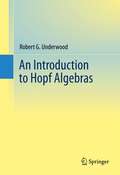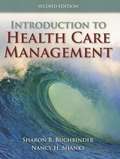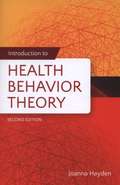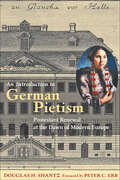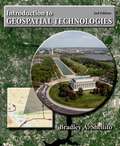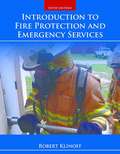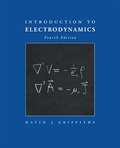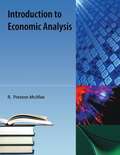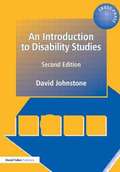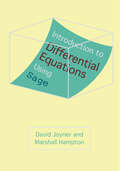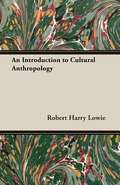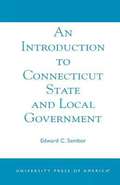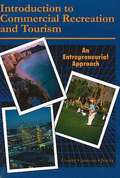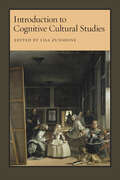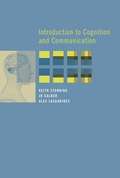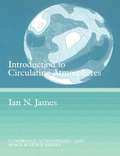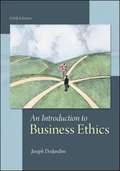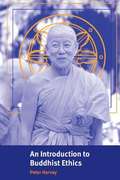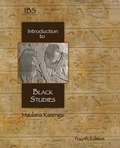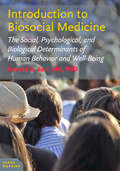- Table View
- List View
An Introduction to Hopf Algebras
by Robert G. UnderwoodWith wide-ranging connections to fields from theoretical physics to computer science, Hopf algebras offer students a glimpse at the applications of abstract mathematics. This book is unique in making this engaging subject accessible to advanced undergraduate and beginning graduate students. After providing a self-contained introduction to group and ring theory, the book thoroughly treats the concept of the spectrum of a ring and the Zariski topology. In this way the student transitions smoothly from basic abstract algebra to Hopf algebras. The importance of Hopf orders is underscored with applications to algebraic number theory, Galois module theory and the theory of formal groups. By the end of the book, readers will be familiar with established results in the field and ready to pose research questions of their own.
Introduction To Health Care Management
by Sharon B. Buchbinder Nancy H. ShanksIntroduction to Health Care Management is a concise, reader-friendly, introductory healthcare management book that covers a wide variety of healthcare settings, from hospitals to nursing homes and clinics. Filled with examples to engage the reader's imagination, the important issues in healthcare management, such as ethics, cost management, strategic planning and marketing, information technology, and human resources, are all thoroughly covered. Guidelines and rubrics along with numerous case studies make this text both student-friendly and teacher friendly. It is the perfect resource for students of healthcare management, nursing, allied health, business administration, pharmacy, occupational therapy, public administration, and public health. "Drs. Buchbinder and Shanks have done a masterful job in selecting topics and authors and putting them together in a meaningful and coherent manner. Each chapter of the book is designed to give the student the core content that must become part of the repertoire of each and every healthcare manager, whether entry level or senior executive. Each of the chapters and accompanying cases serve to bring to life what it means to be a truly competent healthcare manager.
Introduction to Health Behavior Theory (Second Edition)
by Joanna Aboyoun HaydenIntroduction to Health Behavior Theory, Second Edition is designed to provide students with an easy to understand, interesting, and engaging introduction to the theoretical basis of health education. Written with the undergraduate in mind, the text uses comprehensive and accessible explanations to help students understand what theory is, how theories are developed, and what factors influence health behavior theory. Covering the more frequently used health behavior theories, the author breaks each theory into concepts and constructs to enhance comprehension and encourage students to discover how these theories can be put into practice. New to the Second Edition:* Data, information, and illustrations updated throughout, including the new "My Plate"* A new Theory in Action article and new classroom activities in each theory chapter* New and revised chapters on Social Ecological Models and Social Capital Theory
An Introduction to German Pietism: Protestant Renewal at the Dawn of Modern Europe (Young Center Books in Anabaptist and Pietist Studies)
by Douglas H. ShantzAn up-to-date portrait of a defining moment in the Christian story—its beginnings, worldview, and cultural significance.Winner of the Dale W. Brown Book Award of the Young Center for Anabaptists and Pietist Studies at Elizabethtown CollegeAn Introduction to German Pietism provides a scholarly investigation of a movement that changed the history of Protestantism. The Pietists can be credited with inspiring both Evangelicalism and modern individualism.Taking into account new discoveries in the field, Douglas H. Shantz focuses on features of Pietism that made it religiously and culturally significant. He discusses the social and religious roots of Pietism in earlier German Radicalism and situates Pietist beginnings in three cities: Frankfurt, Leipzig, and Halle. Shantz also examines the cultural worlds of the Pietists, including Pietism and gender, Pietists as readers and translators of the Bible, and Pietists as missionaries to the far reaches of the world. He not only considers Pietism's role in shaping modern western religion and culture but also reflects on the relevance of the Pietist religious paradigm of today.The first survey of German Pietism in English in forty years, An Introduction to German Pietism provides a narrative interpretation of the movement as a whole. The book's accessible tone and concise portrayal of an extensive and complex subject make it ideal for courses on early modern Christianity and German history. The book includes appendices with translations of German primary sources and discussion questions.
Introduction to Geospatial Technologies (Second Edition)
by Bradley A. ShellitoCombining both theoretical coverage and hands-on lab work, and accessible to majors and non-majors alike, Bradley Shellito's Introduction to Geospatial Technologies has become a new favorite for the digital Earth course. The new edition reflects the latest developments in the field, including how scientists are using GIS data with cloud technology. With lab activities that utilize both widely available freeware and ArcGIS, instructors can tailor the course to their students.
Introduction to Functional Magnetic Resonance Imaging
by Richard B. BuxtonFunctional Magnetic Resonance Imaging (fMRI) has become a standard tool for mapping the working brain's activation patterns, both in health and in disease. It is an interdisciplinary field and crosses the borders of neuroscience, psychology, psychiatry, radiology, mathematics, physics and engineering. Developments in techniques, procedures and our understanding of this field are expanding rapidly. In this second edition of Introduction to Functional Magnetic Resonance Imaging, Richard Buxton - a leading authority on fMRI - provides an invaluable guide to how fMRI works, from introducing the basic ideas and principles to the underlying physics and physiology. He covers the relationship between fMRI and other imaging techniques and includes a guide to the statistical analysis of fMRI data. This book will be useful both to the experienced radiographer, and the clinician or researcher with no previous knowledge of the technology.
Introduction to Fire Protection and Emergency Services (Fifth Edition)
by Robert W. KlinoffDesigned for use within courses based on the Fire and Emergency Services in Higher Education (FESHE) Principles of Emergency Services model curriculum, this new Fifth Edition will prepare readers for a career in the fire or emergency services. Introduction to Fire Protection and Emergency Services provides an overview of the fire service, from history and culture to the basics of chemistry and physics, fire protection systems, and strategic and tactical considerations for wildland or structural fires. The Fifth Edition has also been updated to include new or expanded coverage of risk management, Next Generation (NG) 9-1-1, the U.S. Fire Problem from local and federal perspectives, wildfire issues and the impacts of global warming, and much more.
Introduction to Electrodynamics (4th Edition)
by David J. GriffithsFor junior/senior-level electricity and magnetism courses. This book is known for its clear, concise, and accessible coverage of standard topics in a logical and pedagogically sound order. The highly polished Fourth Edition features a clear, accessible treatment of the fundamentals of electromagnetic theory, providing a sound platform for the exploration of related applications (ac circuits, antennas, transmission lines, plasmas, optics, etc. ). Its lean and focused approach employs numerous new examples and problems.
Introduction to Economic Analysis
by R. Preston McafeeThis book presents introductory economics ("principles") material using standard mathematical tools, including calculus. It is designed for a relatively sophisticated undergraduate who has not taken a basic university course in economics. It also contains the standard intermediate microeconomics material and some material that ought to be standard but is not. The book can easily serve as an intermediate microeconomics text. The focus of this book is on the conceptual tools and not on fluff. Most microeconomics texts are mostly fluff and the fluff market is exceedingly over-served by $100+ texts. In contrast, this book reflects the approach actually adopted by the majority of economists for understanding economic activity. There are lots of models and equations and no pictures of economists.
Introduction to Economic Analysis
by R. Preston Mcafee Tracy R. LewisThis book presents standard intermediate microeconomics material and some material that, in the authors' view, ought to be standard but is not. Introductory economics material is integrated. Standard mathematical tools, including calculus, are used throughout. The book easily serves as an intermediate microeconomics text, and can be used for a relatively sophisticated undergraduate who has not taken a basic university course in economics. The focus of this book is on the conceptual tools and not on fluff. As such, it reflects the approach actually adopted by the majority of economists for understanding economic activity. There are lots of models and equations, and no pictures of economists ;-) Economic analysis is used in many situations. When British Petroleum sets the price for Alaskan crude oil, it uses an estimated demand model, both for gasoline consumers and also for the refineries to which BP sells. Economic analysis was used by experts in the antitrust suit brought by the U.S. Department of Justice both to understand Microsoft s incentive to foreclose (eliminate from the market) rival Netscape and consumer behavior in the face of alleged foreclosure. Stock market analysts use economic models to forecast the profits of companies to predict the price of their stocks. When the government forecasts the budget deficit or considers a change in environmental regulations, it uses economic models. This book presents the building blocks of the models in common use by an army of economists thousands of times per day. This book, plus econometrics, provides most of the economic analysis tools to take upper division economics courses of any type.
Introduction to Economic Analysis
by R. Preston Mcafee Tracy R. LewisThis book presents standard intermediate microeconomics material and some material that, in the authors' view, ought to be standard but is not. Introductory economics material is integrated. Standard mathematical tools, including calculus, are used throughout. The book easily serves as an intermediate microeconomics text, and can be used for a relatively sophisticated undergraduate who has not taken a basic university course in economics. The focus of this book is on the conceptual tools and not on fluff. As such, it reflects the approach actually adopted by the majority of economists for understanding economic activity. There are lots of models and equations, and no pictures of economists ;-) Economic analysis is used in many situations. When British Petroleum sets the price for Alaskan crude oil, it uses an estimated demand model, both for gasoline consumers and also for the refineries to which BP sells. Economic analysis was used by experts in the antitrust suit brought by the U.S. Department of Justice both to understand Microsoft s incentive to foreclose (eliminate from the market) rival Netscape and consumer behavior in the face of alleged foreclosure. Stock market analysts use economic models to forecast the profits of companies to predict the price of their stocks. When the government forecasts the budget deficit or considers a change in environmental regulations, it uses economic models. This book presents the building blocks of the models in common use by an army of economists thousands of times per day. This book, plus econometrics, provides most of the economic analysis tools to take upper division economics courses of any type.
An Introduction to Distributed Algorithms
by Valmir C. BarbosaAn Introduction to Distributed Algorithms takes up some of the main concepts and algorithms, ranging from basic to advanced techniques and applications, that underlie the programming of distributed-memory systems such as computer networks, networks of workstations, and multiprocessors. Written from the broad perspective of distributed-memory systems in general it includes topics such as algorithms for maximum flow, program debugging, and simulation that do not appear in more orthodox texts on distributed algorithms. Moving from fundamentals to advances and applications, ten chapters--with exercises and bibliographic notes--cover a variety of topics. These include models of distributed computation, information propagation, leader election, distributed snapshots, network synchronization, self- stability, termination detection, deadlock detection, graph algorithms, mutual exclusion, program debugging, and simulation. All of the algorithms are presented in a clear, template- based format for the description of message-passing computations among the nodes of a connected graph. Such a generic setting allows the treatment of problems originating from many different application areas. The main ideas and algorithms are described in a way that balances intuition and formal rigor--most are preceded by a general intuitive discussion and followed by formal statements as to correctness complexity or other properties.
Introduction to Disability Studies
by David JohnstoneAn introductory text that explores the current issues in the lives and circumstances of disabled people, their careers, and those who intend to work in the caring services. Explores and analyzes quality of life factors, the emergence of rights, and the strengths and weakness of community care provisions. Also provides examples of individual oppressions and success stories, and suggests how disabled and non-disabled people can collaborate in the development of inclusive communities and neighborhoods. Distributed by Taylor & Francis. Annotation c. by Book News, Inc., Portland, OR.
Introduction to Differential Equations Using Sage
by David Joyner Marshall HamptonDifferential equations can be taught using Sage as an inventive new approach.David Joyner and Marshall Hampton's lucid textbook explains differential equations using the free and open-source mathematical software Sage.Since its release in 2005, Sage has acquired a substantial following among mathematicians, but its first user was Joyner, who is credited with helping famed mathematician William Stein turn the program into a usable and popular choice. Introduction to Differential Equations Using Sage extends Stein's work by creating a classroom tool that allows both differential equations and Sage to be taught concurrently. It's a creative and forward-thinking approach to math instruction.Topics include: • First-Order Differential Equations • Incorporation of Newtonian Mechanics• Second-Order Differential Equations• The Annihilator Method• Using Linear Algebra with Differential Equations• Nonlinear Systems• Partial Differential Equations• Romeo and Juliet
Introduction to Criminal Justice (Eighth Edition)
by Robert Bohm Keith HaleyIntroduction to Criminal Justice is the perfect text for students who are interested in pursuing a career in criminal justice and for those who simply want to learn more about the criminal justice system. The authors' combined experience of more than 50 years in teaching introduction to criminal justice as well as working in the field -- Bohm as a correctional officer and Haley as a police officer -- come through in their accessible yet comprehensive presentation. They make it easy for readers to understand that much of what the public "knows" about criminal justice in the United States is myth, and help students learn the truth about the U. S. criminal justice system. With the CourseSmart eTextbook version of this title, students can save up to 50% off the cost of a print book, reduce their impact on the environment, and access powerful web tools for learning. Faculty can also review and compare the full text online without having to wait for a print desk copy. CourseSmart is an online eTextbook, which means users need to be connected to the internet in order to access. Students can also print sections of the book for maximum portability.
An Introduction to Connecticut State and Local Government
by Edward C. SemborThis is a comprehensive text for political science courses focused on state and local government.Included are discussions on the governor, General Assembly, the judicial branch, political parties, interest groups and elections.
Introduction to Commercial Recreation and Tourism: An Entrepreneurial Approach (5th edition)
by John C. Crossley Lynn M. Jamieson Russell E. BrayleyIntroduction to Commercial Recreation and Tourism is a stepping stone to understanding the scope, characteristics, entrepreneurial strategies and management aspects of commercial recreation and tourism. Topics include the history of commercial recreation, definitions, economic applications, business start-up strategies, financing, marketing, operations management, and global trends. This edition also examines industry profiles for the travel, hospitality, and local commercial recreation industries. The Journal of Park and Recreation Administration viewed the past edition as a 'valuable addition to commercial recreation literature'.
Introduction to Cognitive Cultural Studies
by Lisa ZunshineDrawing on the explosion of academic and public interest in cognitive science in the past two decades, this volume features articles that combine literary and cultural analysis with insights from neuroscience, cognitive evolutionary psychology and anthropology, and cognitive linguistics. Lisa Zunshine’s introduction provides a broad overview of the field. The essays that follow are organized into four parts that explore developments in literary universals, cognitive historicism, cognitive narratology, and cognitive approaches in dialogue with other theoretical approaches, such as postcolonial studies, ecocriticism, aesthetics, and poststructuralism. Introduction to Cognitive Cultural Studies provides readers with grounding in several major areas of cognitive science, applies insights from cognitive science to cultural representations, and recognizes the cognitive approach’s commitment to seeking common ground with existing literary-theoretical paradigms. This book is ideal for graduate courses and seminars devoted to cognitive approaches to cultural studies and literary criticism.Contributors: Mary Thomas Crane, Nancy Easterlin, David Herman, Patrick Colm Hogan, Bruce McConachie, Alan Palmer, Alan Richardson, Ellen Spolsky, G. Gabrielle Starr, Blakey Vermeule, Lisa Zunshine
Introduction to Cognition and Communication
by Keith Stenning Alex Lascarides Jo CalderThis introduction to the interdisciplinary study of cognition takes the novel approach of bringing several disciplines to bear on the subject of communication. Using the perspectives of linguistics, logic, AI, philosophy, and psychology--the component fields of cognitive science--to explore topics in human communication in depth, the book shows readers and students from any background how these disciplines developed their distinctive views, and how those views interact. The book introduces some sample phenomena of human communication that illustrate the approach of cognitive science in understanding the mind, and then considers theoretical issues, including the relation of logic and computation and the concept of representation. It describes the development of a model of natural language and explores the link between an utterance and its meaning and how this can be described in a formal way on the basis of recent advances in AI research. It looks at communication employing graphical messages and the similarities and differences between language and diagrams. Finally, the book considers some general philosophical critiques of computational models of mind. The book can be used at a number of different levels. A glossary, suggestions for further reading, and a Web site with multiple-choice questions are provided for nonspecialist students; advanced students can supplement the material with readings that take the topics into greater depth.
Introduction to Circulating Atmospheres
by Alexander J. Dessler John T. Houghton Michael J. Rycroft Ian N. JamesThis book gives an account of the modern view of the global circulation of the atmosphere. It brings the observed nature of the circulation together with theories and simple models of the mechanisms which drive it. Early chapters concentrate on the classical view of the global circulation, on the processes which generate atmospheric motions and on the dynamical constraints which modify them. Later chapters develop more recent themes including low frequency variability and the circulations of other planetary atmospheres. The book will be of interest to advanced students and researchers who wish for an introduction to the subject before engaging with the original scientific literature. The book is copiously illustrated, and includes many results of diagnostic and modeling studies. Each chapter includes a set of problems and bibliographical notes.
An Introduction to Business Ethics, 5th Edition
by Joseph DesjardinsSince its inception, An Introduction to Business Ethics by Joseph DesJardins has been a cutting-edge resource for the business ethics course. DesJardins’ unique multidisciplinary approach offers critical analysis and integrates the perspective of philosophy with management, law, economics, and public policy, providing a clear, concise, yet reasonably comprehensive introductory survey of the ethical choices available to us in business.
An Introduction to Buddhist Ethics: Foundations, Values and Issues
by Peter HarveyThis systematic introduction to Buddhist ethics is aimed at anyone interested in Buddhism, including students, scholars and general readers. Peter Harvey is the author of the acclaimed Introduction to Buddhism (Cambridge, 1990), and his new book is written in a clear style, assuming no prior knowledge. At the same time it develops a careful, probing analysis of the nature and practical dynamics of Buddhist ethics in both its unifying themes and in the particularities of different Buddhist traditions. The book applies Buddhist ethics to a range of issues of contemporary concern: humanity's relationship with the rest of nature; economics; war and peace; euthanasia; abortion; the status of women; and homosexuality. Professor Harvey draws on texts of the main Buddhist traditions, and on historical and contemporary accounts of the behaviour of Buddhists, to describe existing Buddhist ethics, to assess different views within it, and to extend its application into new areas.
Introduction to Black Studies (4th Edition)
by Maulana KarengaA comprehensive textbook that covers Black/African American studies across a variety of academic disciplines.
Introduction to Biosocial Medicine: The Social, Psychological, and Biological Determinants of Human Behavior and Well-Being
by Donald A. BarrUnderstanding human behavior is essential if medical students and doctors are to provide more effective health care.While 40 percent of premature deaths in the United States can be attributed to such dangerous behaviors as smoking, overeating, inactivity, and drug or alcohol use, medical education has generally failed to address how these behaviors are influenced by social forces. This new textbook from Dr. Donald A. Barr was designed in response to the growing recognition that physicians need to understand the biosocial sciences behind human behavior in order to be effective practitioners. Introduction to Biosocial Medicine explains the determinants of human behavior and the overwhelming impact of behavior on health. Drawing on both recent and historical research, the book combines the study of the biology of humans with the social and psychological aspects of human behavior. Dr. Barr, a sociologist as well as physician, illustrates how the biology of neurons, the intricacies of the human mind, and the power of broad social forces all influence individual perceptions and responses. Addressing the enormous potential of interventions from medical and public health professionals to alter these patterns of human behavior over time, Introduction to Biosocial Medicine brings necessary depth and perspective to medical training and education.
